Baseboard fits Pico-ITX into DIN slots
Feb 4, 2010 — by LinuxDevices Staff — from the LinuxDevices Archive — 4 viewsVia Technologies announced a baseboard designed to integrate a previously released, Linux-ready Pico-ITXe board into a car's instrument panel. The Epia-P710-D offers three Mini PCI Express slots, a SIM slot, SD card reader, plus USB, IDE, and SATA ports, according to the company.
Via's new Epia-P710-D baseboard is said to have been expressly designed to host the company's previously released Epia-P710, which is detailed later in this story. Dwarfing this Pico-ITXe board itself, the Epia-P710-D is said to fit into a single DIN (ISO 7736) slot in a car's dashboard, though the company did not provide overall dimensions.
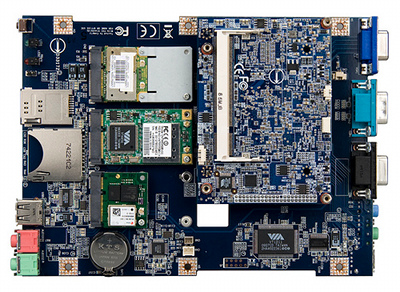
A top view of Via's Epia-P710-D, with the Epia-P710 on board
(Click to enlarge)
Billing the Epia-P710-D (above) as a "fleet management hardware platform," Via says that in combination with the Epia-P710, the device is suitable for applications such as fuel management, active scheduling, advanced routing, asset monitoring and "the latest emergency, safety and rescue features." Three Mini PCI Express slots are provided, accepting a wide range of WiFi, GSM, 3G/3.5G, GPS, and GPRS modules, the company adds.
The left-hand image below shows the Epia-P710-D without the Epia-P710 in place, and without any Mini PCI Express cards on board. The right-hand image shows what the device looks like with the Pico-ITXe board and sample Mini PCI Express boards in place.
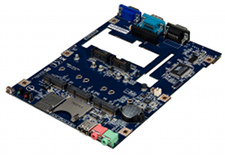
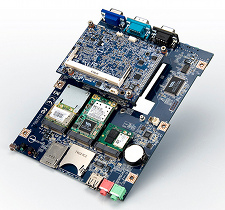
Via's Epia-P710D without (left) and with (right) boards in place
(Click either to enlarge)
According to Via, front-side I/O on the Epia-P710-D includes, from left to right, a SIM slot, an SD card reader, two USB 2.0 ports, plus two 3.5mm audio jacks. Rear I/O, meanwhile, is said to consist of a VGA port, a serial port, and access to an unspecified number of GPIOs.
Daniel Wu, VP of Via's embedded platform division, stated, "The Via Epia-P710-D can be used to create a range of incredibly versatile and full featured in-vehicle devices that can communicate and increasingly make intelligent management decisions. The Pico-ITXe standard also offers a uniquely modular approach to platform design, facilitating faster time-to-market and design cycles."
Background
Via created its 3.9 x 2.8-inch Pico-ITX motherboard format in 2007, touting it as enabling "the smallest complete x86 mainboard in the industry." Ownership of the spec was transferred to the Small Form-Factor Special Interest Group in 2008, and later the same year, Via unveiled Pico-ITXe, a version adding the SFF-SIG's SUMIT expansion interface.
Instead of using pins that pass all the way through the board, like PC/104, SUMIT, pictured below, uses a pair of one-sided, surface-mount QMS/QFS (quiet male "635"/quiet female "635") connectors with 52 pins each. Boards (typically I/O boards) that need pass-through do so with "vias" in the printed circuit board. Each connector is tiny, measuring less than an inch long, and optimized for a stand-off height of just a sixth of an inch (15.24mm).
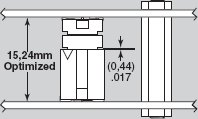
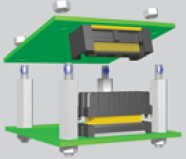
The SUMIT physical interface
(Source: Samtec)
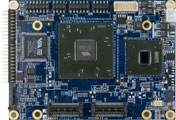 Also announced in 2008, the Via Epia-P710, pictured at left, was the company's first pico-ITXe board. It includes a 1GHz Via C7 processor, up to 2GB of DDR2 memory, and supports Linux, Windows CE, and Windows XP/XPe. According to Via, the board is equipped with one IDE channel and dual SATA channels, and pin headers are said to provide access to gigabit Ethernet, VGA, LVDS, audio, and front panel LEDs. The Epia_P710's two SUMIT connectors integrate LPC, SPI, SMBus, and three USB 2.0 interfaces, according to Via.
Also announced in 2008, the Via Epia-P710, pictured at left, was the company's first pico-ITXe board. It includes a 1GHz Via C7 processor, up to 2GB of DDR2 memory, and supports Linux, Windows CE, and Windows XP/XPe. According to Via, the board is equipped with one IDE channel and dual SATA channels, and pin headers are said to provide access to gigabit Ethernet, VGA, LVDS, audio, and front panel LEDs. The Epia_P710's two SUMIT connectors integrate LPC, SPI, SMBus, and three USB 2.0 interfaces, according to Via.
Via's first SUMIT-based expansion option for the Epia-P710 was the Epia-P710-HD, which supplemented the Pico-ITXe board's onboard Via Chrome9 graphics with a S3 Graphics 4300e. This GPU (graphics processing unit) was said to add 1080p HD playback and dual DVI/HDMI display support.
With its release of the Epia-P710-D, Via has now repurposed SUMIT as a means of connecting a baseboard. Therefore, it is apparently impossible to connect both the Epia-P710-D and the Epia-P710-HD at once: If there's enough demand for in-car HD video, Via will presumably simply integrate a GPU onto a forthcoming baseboard product.
Availability
Via did not list pricing or availability for the Via P710-D module, but further information on Pico-ITX may be found using the links below. Meanwhile, last December Via released an even smaller format, the 2.36 x 2.36-inch Mobile-ITX. For more details, see our earlier coverage, here and here.
This article was originally published on LinuxDevices.com and has been donated to the open source community by QuinStreet Inc. Please visit LinuxToday.com for up-to-date news and articles about Linux and open source.